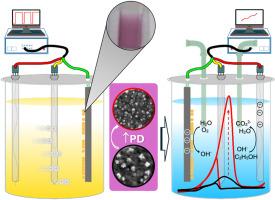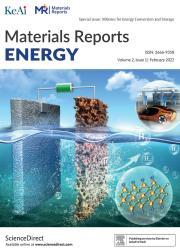Efficient stabilizing agent-free synthesis of gold nanoparticles via square-wave pulse deposition for enhanced catalytic performance in ethanol electrooxidation
引用次数: 0
Abstract
The pressing environmental concerns and the depletion of fossil fuel reserves necessitate a transition toward sustainable energy sources. Ethanol, a renewable biomass-derived fuel, is a promising alternative due to its availability and high energy density. This study investigates the synthesis of gold nanoparticles (Au NPs) via a square-wave pulse deposition technique, aiming to enhance catalytic activity for ethanol electrooxidation. By varying pulse durations, we were able to exert precise control over Au NP size and distribution without stabilizing agents. Characterization using field emission scanning electron microscopy and X-ray diffraction techniques confirmed the formation of clustered nanoparticles of metallic gold phase. Electrochemical characteristics analyses revealed that Au NPs synthesized with a 900 ms pulse duration exhibited the lowest charge transfer resistance and the highest electrochemically active surface area. The electrocatalytic performance test of these Au NPs demonstrated an anodic current density of 2.5 mA cm−2 and a Tafel slope of 78 mV dec−1, indicating superior catalytic performance and reaction kinetics. Additionally, the Au NPs showed high resistance to poisoning, as evidenced by a low jb/jf ratio of 0.28 and stable chronoamperometric response. These findings underscore the potential of this synthesis method for producing high-performance electrocatalysts utilized in exploiting ethanol's potential as an environmentally friendly energy carrier.

无稳定剂的方波脉冲沉积法制备金纳米颗粒以提高乙醇电氧化的催化性能
紧迫的环境问题和化石燃料储备的枯竭要求向可持续能源过渡。乙醇是一种可再生的生物质衍生燃料,由于其可用性和高能量密度,是一种很有前途的替代品。本研究利用方波脉冲沉积技术合成金纳米颗粒(Au NPs),以提高其对乙醇电氧化的催化活性。通过改变脉冲持续时间,我们能够在没有稳定剂的情况下精确控制Au NP的大小和分布。利用场发射扫描电子显微镜和x射线衍射技术进行表征,证实了金属金相簇状纳米颗粒的形成。电化学特性分析表明,在900 ms脉冲时间下合成的Au NPs具有最低的电荷转移电阻和最高的电化学活性表面积。电催化性能测试表明,这些Au NPs的阳极电流密度为2.5 mA cm−2,Tafel斜率为78 mV dec−1,表明了优异的催化性能和反应动力学。此外,Au NPs具有较高的抗中毒能力,其jb/jf比低至0.28,且具有稳定的时温响应。这些发现强调了这种合成方法生产高性能电催化剂的潜力,用于开发乙醇作为环境友好型能源载体的潜力。
本文章由计算机程序翻译,如有差异,请以英文原文为准。
求助全文
约1分钟内获得全文
求助全文
来源期刊

材料导报:能源(英文)
Renewable Energy, Sustainability and the Environment, Nanotechnology
CiteScore
13.00
自引率
0.00%
发文量
0
审稿时长
50 days
 求助内容:
求助内容: 应助结果提醒方式:
应助结果提醒方式:


